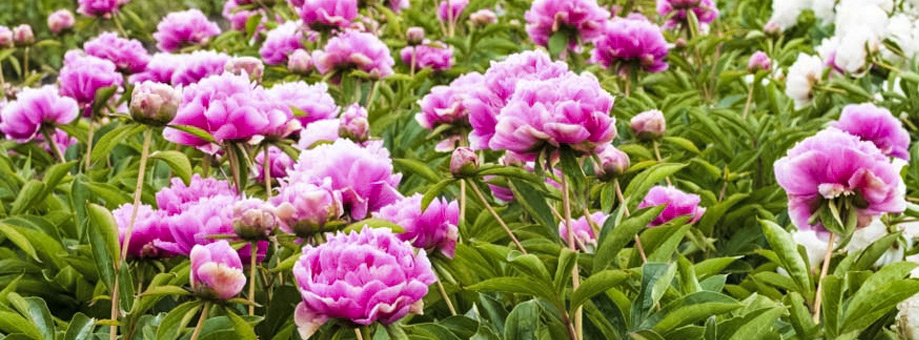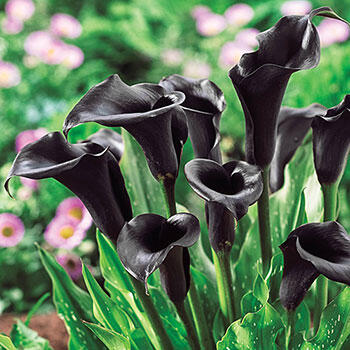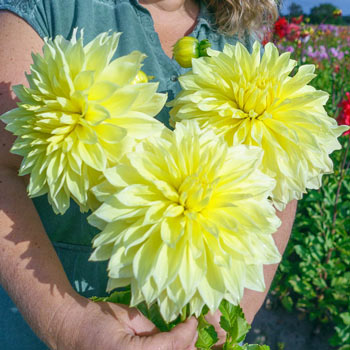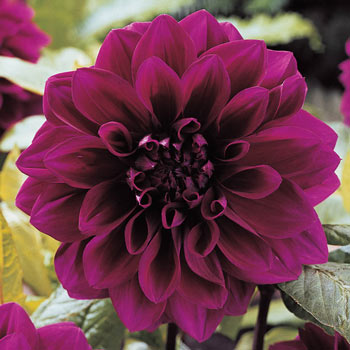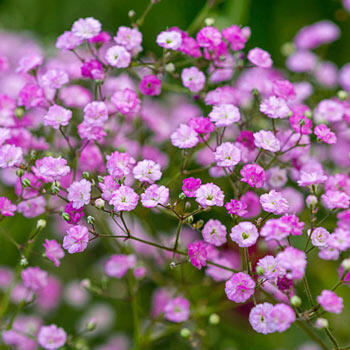- About Bulbs
- Landscaping Tips
- Planting & Care of Bulbs
- Tips for buying Bulbs & Perennials
- Planting &
Growing Instructions
- All ium Planting and Growing Tips
- B egonias Planting and Growing Tips
- Calla Lily Planting and Growing Tips
- Cro cus Planting and Growing Tips
- Daffodil Planting and Growing Tips
- Da hlia Planting and Growing Tips
- Daylily Planting and Growing Tips
- Gladiolus Planting and Growing Tips
- Hyacinth Planting and Growing Tips
- Iris Planting and Growing Tips
- Lil y Planting and Growing Tips
- Pe ony Planting and Growing Tips
- Rose Planting and Growing Tips
- Tul ip Planting and Growing Tips
When to Plant Peonies
Wondering when to plant peony bulbs? Planting the peonies as soon as you receive them is important because they are shipped bare root. The plants are field-grown and have been harvested recently.
If you don't have time to plant immediately, keep the peony roots in their original bags at about 40°F [5°C] (the vegetable drawer of a refrigerator is ideal) for no longer than three weeks.
Quick planting, however, will give the best results. In general, planting peonies before the first frost of fall is recommended.
Don't worry if the roots appear to be dry when they arrive. We advise to soak the roots in cold to luke warm water for about 30 minutes prior to planting. Peonies will form additional new roots this fall, immediately after planting.
When Are Peonies in Season?
Peonies peak season begins during early spring and carries out until late June. Even though peonies have a short blooming season, you will be delighted by the dramatic and beautiful peony blooms most often seen during the month of May.
Where to Plant Peonies
Decide where to plant your peonies by picking a site with the following characteristics:
- Full sun to partial shade (for instance morning sun and afternoon shade, or dappled sun throughout the day). Peonies need at least 4 to 6 hours of direct sunlight per day to bloom.
- Well-drained soils. Avoid soils that become waterlogged from time to time.
- Peonies are tolerant of a wide range of pH but prefer neutral to slightly alkaline soils.
- Peonies tolerate a wide variety of soil types (from clay to sand). Peonies planted in clay soil take a bit longer to become established but produce bigger and stronger plants as clay soil retains nutrition. Peonies planted in sandy soil take less time to become established but may grow less vigorous as nutrients easily leech out of the soil.
How to Prepare the Site and Work the Soil
As peonies prefer to be left in one location for generations, it is worth taking the time to dig a proper hole and amend the soil.
Before planting peony bulbs, spade or rototill the soil to a depth of 12-15".
Mix in a generous 2-4" layer of dehydrated manure, garden compost and Breck' s Food for Bulbs and Perennials. This is not too rich in nitrogen, making it an ideal peony fertilizer.
If your soil is already rich garden loam and well drained, the addition of Breck's Food for Bulbs and Perennials will provide the ideal conditions recommended by Breck's Dutch bulb experts for superior growth and blooming.
If you have a clay soil you may need to amend for drainage. A good solution is to mix compost and rock dust or crushed stone into your soil.
If you have sandy soil, amend with compost and possibly clay to increase the retention of nutrients. This will also help to better retain moisture.
How to Plant Peony Bulbs and Roots
When it comes to planting peony bulbs, soak the roots in cold to lukewarm water for about 30 minutes prior to planting.
Planting Bush and Itoh Peonies
Position the root so that the eyes (pink buds) will be just below the soil (between 0.5 and 1" below ground level). If planted deeper, it will take longer for your peonies to flower.
Fill in the hole with soil, carefully packing soil around the roots with your fingers. Do not damage the tender pink eyes. Water thoroughly.
Planting Tree Peonies
Plant the grafted bare root tree peony deeply. The graft union should be 3-4" below the soil. This will encourage the tree peony to make fresh roots and basal shoots.
Don't overwater newly planted tree peonies. This is the biggest cause of failure.
Tree peonies are slow starters. Sometimes a newly planted tree peony will appear to make little growth, if any, in its first season. Don't panic--especially if the foliage looks healthy. All activity happens underground . This may just be a "setting in" period. Occasionally, the main stems may die back a little. Although this might look worrisome, wait until next spring, when vigorous growth should resume from the lower part of the stem or even from below soil level.
Bush and itoh peonies should be spaced approximately 2 to 3 feet apart. Tree peonies can best be spaced at least 4 to 5 feet apart.
How to Grow and Care for Peonies After Planting
Peonies have relatively simple care instructions after planting in order for these perennials to grow into healthy flowers that will brighten any garden with colorful blooms.
Caring for Peonies and Preparing Them for Winter
A year-round mulch of compost, leaf mold, leaves, or commercial types of mulch has a positive effect on your peonies by keeping the soil from drying out, maintaining a more even soil temperature, providing organic matter for an optimal structure of the soil, and reducing weed growth. It also prevents soil from splashing onto the flowers and foliage. For the first winter, we advise putting a thick, 4-6" layer of mulch over your freshly planted peony to prevent roots from being heaved out of the ground by alternate freezing and thawing weather.
Tree peonies are less hardy than bush peonies. In addition to the mulch, we advise protecting tree peonies planted in zones 4, 5, and possibly 6 with a windbreaker to help protect the flower buds during severe winter weather.
Ongoing Care for Peony Plants
Once your peonies are planted, a surface application of Breck's Food for Bulbs and Perennials is recommended each spring just as the peony foliage begins to unfurl. If natural rainfall is less than 1" per week, additional watering is recommended.
Caring for Bush and Itoh Peonies
Deadhead peonies blossom as soon as they begin to fade, cutting your peonies to a strong leaf so that the stem doesn't stick out of the foliage.
After the first frosts of fall blacken the foliage, cut your peonies to just above ground level, and discard.
Once peonies are established, annual winter mulching is not necessary as winter protection, but it is beneficial for the plants as described above.
Caring for Tree Peonies
Tree peonies require minimal pruning or cutting. If needed, cut back your tree peonies just above new growth in summer or fall. Over time, the stems may become leggy. Removal of the oldest stems down to the base after leaf-fall encourages bushier growth. It's best not to attempt hard-renovation pruning.
Once planted, your peonies can be left to grow undisturbed indefinitely. Don't be disappointed, however, if your peonies fail to bloom the first year and have only a few blossoms the second season. It usually takes three years for a Bush and Itoh peony to attain mature size, whie tree peonies take even longer to reach mature size.
How to Plant Peonies in Pots
It is best to use containers of 10 gallons or larger when planting peonies. The bigger the pot the better. Commercial potting mixes are available, look for those with extra porosity. Containers will need to remain outside in the winter as peonies need the cold season to flower. Bush peonies are the hardiest of all, so these are most suitable for container growing. If you are afraid that your peony may not survive a very cold spell, move the pot indoors into a cool place. Place the pot outside again when temperatures rise again. Be sure that your pots have drainage holes so that the pots do not fill with water as this will cause peonies to rot. Peonies are especially susceptible in winter when lack of significant drainage will cause the pots to freeze and fill with ice.
Tree peonies and itoh peonies can also be grown in pots, but both are less hardy than bush peonies. Extra measures during cold spells may be necessary, like moving pots indoors or protection from insulated material.
How to Create More Peonies
The easiest and most successful way of creating more peonies is to divide them. Dividing is best done in the fall when the foliage has turned brown.
How to Divide Bush and Itoh Peonies
Dig up the plant and divide the plant into pieces by carefully cutting through the crown with a spade or sharp knife. Each piece should have at least one strong tuberous root and 3-5 eyes.
How to Divide Tree Peonies
Dividing tree peonies is very difficult and not recommended. The rate of success is very low.
Tips on Transplanting Peonies
Transplanting a peony is best done in the fall when the plant has become dormant. To lift an established peony, loosen the plant from the soil with a large garden fork or spade, work your way around the plant, and gently pry it from the ground. The roots are brittle and can easily be broken, so be careful.
Any time peonies are transplanted or divided, it may take up 2 to 3 years before they will flower as freely as before.
How to Cut Peony Flowers
Harvest peony flowers for bouquets when the flower buds show the first signs of opening. If they're still as hard and round as a bullet, they won't open fully. Cut the stems at an angle. Fill the vase with fresh, cold water.
If you grow peonies solely for cut flower use, make sure you leave enough foliage on the plants.
Common Peony Diseases and Pests
Peonies are among the toughest perennials and exhibit excellent disease resistance. The most serious peony disease is Botrytis or grey mold, which most often occurs during cold, wet springs. Remove and destroy all affected stems and foliage immediately and disinfect the pruning shears after use. To avoid this fungal disease, good air circulation around your plants (spacing) and watering early in the day will help. Peonies are generally deer resistant.
You May Like...







